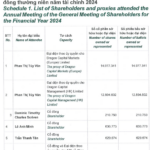Banks Step Up Real Estate Lending
According to our statistics from 14 banks that disclosed detailed loan portfolio analyses by industry for the first half of 2025, the total outstanding real estate loans of these 14 banks as of June 30, 2025, amounted to approximately VND 891 trillion.
Excluding LPBank and VPBank, which recorded declines, the remaining 12 banks all increased real estate lending compared to the end of 2024. Among them, PVCombank maintained its top position for the second consecutive year, surpassing Techcombank to become the largest real estate lender.
In the securities sector, the estimated total outstanding securities loans of the top 40 securities companies as of the end of the second quarter reached a record high of VND 285 trillion.
At the Government’s regular meeting in July, Governor of the State Bank of Vietnam (SBV) Nguyen Thi Hong stated: System-wide credit in the first seven months of the year increased by about 10% compared to the end of 2024 – a significant rise compared to the same period last year’s 6%.
Regarding the concern that credit is heavily flowing into real estate and securities, Governor Nguyen Thi Hong analyzed: The growth rate of credit in these two sectors is indeed higher than the average, but it aligns with the orientation of resolving difficulties for the real estate market. As projects are unblocked legally, capital demand for implementation is inevitable.
In the securities sector, despite the rapid growth, the outstanding loans account for only 1.5% of the total outstanding loans, posing no risk to the entire system. The SBV affirmed that it is still closely monitoring safety indices.
Currently, the ratio of short-term capital used for medium and long-term loans remains below the 30% threshold. At the same time, the agency continuously requires credit institutions to balance capital by maturity to ensure the safety of the entire system.
 Illustration: Nam Khanh
|
Caution with Real Estate Credit
According to economic expert, Assoc. Prof. Dr. Dinh Trong Thinh, the credit growth rate for real estate and securities in the first seven months is not worrying as the SBV is directing the credit policy well into specific industries.
Moreover, the expert stated that credit for the two sensitive sectors of real estate and securities has been increasing healthily in recent years.
“In principle, outstanding loans do not decrease but only increase, but this growth is beneficial to the market, and there is no cause for concern. Even in the US and EU countries, a general market increase is observed,” Assoc. Prof. Dr. Dinh Trong Thinh analyzed.
Mr. Thinh also said that, in the current economic context, as the legal corridor has been and is being improved, we have learned lessons from the past, so the credit growth rate for sectors such as real estate and securities is not worrying and still controllable.
In an interview with us, Assoc. Prof. Dr. Pham The Anh, lecturer at the National Economics University, said that to accurately assess the risk of credit to real estate and securities, specific lending data is necessary.
Basically, the SBV does not publish specific data but only announces general information about the higher credit growth rate in the real estate and securities sectors compared to the overall growth rate.
However, the credit flow into the securities sector is not worrying. “In the case of securities, when investors trade more, they borrow more, which is only temporary,” said Pham The Anh.
“But with real estate, the large amount of credit flowing into this field poses greater risks because capital mainly goes into projects instead of production. In the context of an economy heavily dependent on real estate, increasing credit in this sector further increases risks,” he warned.
Without going into specific comments, the economic expert worried that old debts have not been repaid, while new debts are increasing, which will push real estate prices up, causing instability for the economy. Therefore, caution is required in increasing credit for the real estate sector.
“Credit for real estate should be used for construction and completion of projects to bring products to the market at reasonable prices, instead of hoarding and pushing up real estate prices,” Pham The Anh noted.
|
At the Government’s regular meeting in July, Governor Nguyen Thi Hong affirmed that in the first seven months of 2025, the SBV had proactively and flexibly managed monetary policy, closely following practical developments. Monetary regulation measures were implemented to simultaneously support growth and control inflation. The money supply indices also recorded significant growth. Money supply increased by 7.5% compared to the end of 2024, nearly doubling the same period last year’s growth. Regarding long-term solutions, the Governor emphasized the need for synchronous solutions to support the more effective operation of monetary policy. Among them, two proposals were considered key. First, vigorously develop the capital market to meet medium and long-term capital needs, thereby reducing pressure on the banking system’s short-term capital. This orientation has been agreed upon by the Government in the latest dispatch. Second, expand the credit guarantee program for small and medium-sized enterprises. If these enterprises are supported through the credit guarantee mechanism, it will create a strong production impetus across all sectors of the economy. Additionally, for sectors such as real estate and infrastructure, which require substantial medium and long-term capital, it is advisable to raise funds through corporate bond issuance, local bond issuance, or international loans. “Only by raising capital through the appropriate channels and in line with the nature of the capital can we achieve both high growth and sustainable stability,” emphasized Governor Nguyen Thi Hong. |
Tuan Nguyen
– 06:00 11/08/2025
Unlocking the Secrets to Effective Real Estate Investment: A Comprehensive Guide by the Ministry of Construction
The growth rate of credit for real estate across many banks has reached an impressive 20-30%, an astounding threefold increase compared to the overall credit growth rate of the system. The Ministry of Construction suggests that the State Bank should develop a special credit package for reasonably priced housing to further stimulate credit growth.
Unlocking the Secrets to Effective Real Estate Investment: A Comprehensive Guide by the Ministry of Construction
The growth rate of credit for real estate across many banks has reached an impressive 20-30%, an astounding threefold increase compared to the overall credit growth rate of the system. The Ministry of Construction suggests that the State Bank should develop a credit package for reasonably priced housing to further boost this credit growth.
Prime Minister Requests SBV to Hasten the Development of a Roadmap to Pilot the Abolition of Credit Room from 2026 Onwards.
The State Bank of Vietnam (SBV) needs to establish standards and criteria for credit institutions to operate effectively and maintain good health. These standards should emphasize the importance of strong governance and management capabilities, adherence to prudential ratios, and high credit quality indicators. Transparency and disclosure are key to ensuring the safety and soundness of Vietnam’s banking system.










































